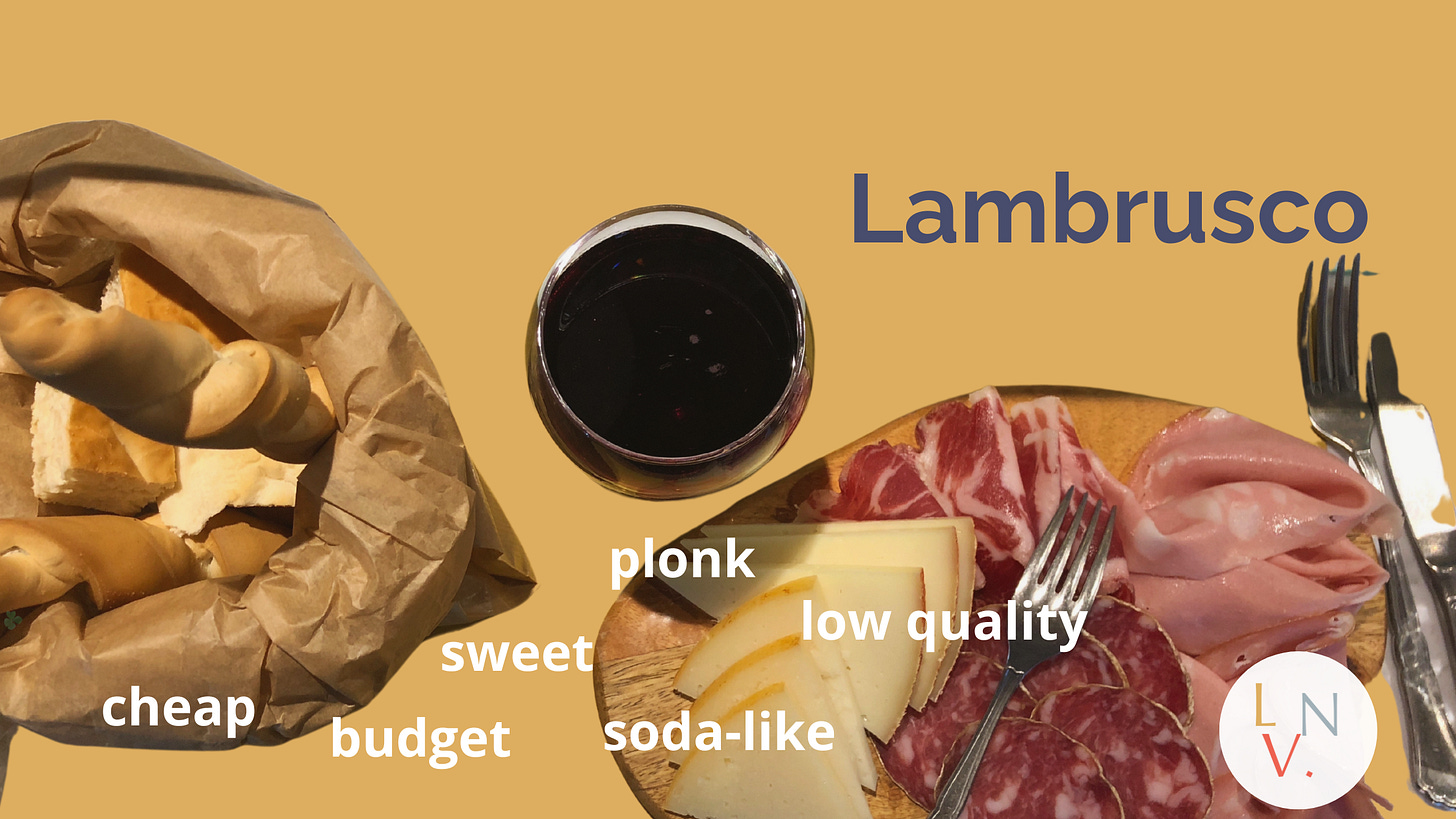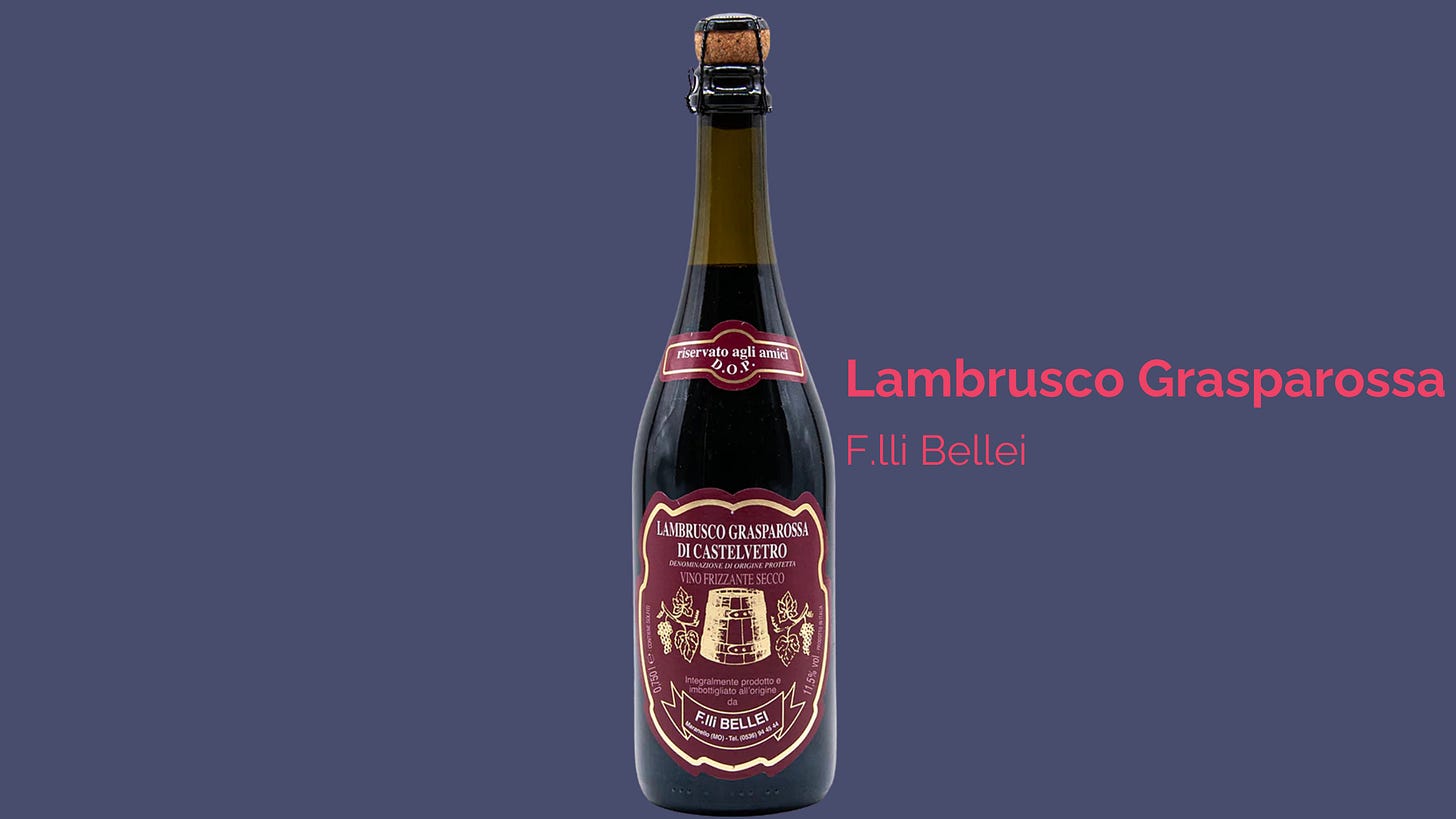Dear reader,
When I sat down to do the blind tasting for the VinItaly Ambassador program at the end of March, I was shocked to see that the wine being poured into my glass was a sparkling red. Nine times out of ten, the red wine that is tested is a still, dry style. And yet, I was looking at something that was red, though light in color, and sparkling in my glass. Could it be Lambrusco? After one deep sniff, I knew that it was not. It was all floral, candy, and fruit. It lacked the Lambrusco-ish quality that I can only describe as charming, approachably fruity with a less prominent yet still present dimension of savoriness (something that reminds me of cured meats). I was right. The wine was not Lambrusco from Emilia but Brachetto d’Acqui from Piedmont. My friend Lambrusco served me well during a difficult and stressful exam and continues to be one of my favorite wines, despite its preceding reputation.
First impressions
I have come to know and appreciate Lambrusco for a long time. It was, without even knowing it at the time, my first ever wine purchase. I met Lambrusco during my undergrad study abroad program at the Università di Bologna. I remember it vividly: it was my first outing to the Italian grocery store, and I, a twenty year-old, was thrilled to purchase my first bottle of wine, since I couldn’t yet do so in the U.S. After several confused minutes of hemming and hawing around the wine aisle, I spotted the perfect, 4-euro bottle that sat right at eye level. At the time, I had no idea what I was looking at, but it was labeled “spumante,” which I knew meant “bubbly,” and sounded good enough to me.
When I popped the cork with friends later that evening, I was surprised to find that it was a sparkling red wine with a little bit of sweetness. It was completely new and different to me, and I loved it immediately; the only sparkling wines I’d tasted before that moment were either white or rosè. I probably repurchased that bottle ten times during my semester abroad, not knowing anything about where it came from or what it was: Lambrusco.
I didn’t revisit Bologna until 2018, and then, I had more wherewithal to look up a little bit more about the typical food and drink of the area. Sure enough, Lambrusco was at the top of the list. I made sure to order a glass along with another local product, mortadella and gnocco fritto. Perfection.
Reputation: Lambrusco’s version
When I began my WSET journey in 2019, I recall my instructor poo-pooing Lambrusco, as well as Prosecco. Apparently, the only sparkling wines I should care about were Champagne and other metodo classico wines, Crémant, Cava, and Franciacorta (probably in that order). That stung a little bit, as I had fond memories of my friend Lambrusco. But, the instructor was surely smarter than me, so I believed him…for a while.
Fast forward to the present day, and I’ve found my way exactly back where I started, to my unwavering admiration for Lambrusco: a sparkling red charmer that represents my first foray into fermented grapes as a young adult and remains relevant to my taste today. Though commonly put down by wine snobs and the like, Lambrusco is a chameleon wine for all (legal) ages, is suitable for many social situations, and should not be ignored. Lambrusco is at once approachable, charming, and easy but not simple. It is good but does not make you think too much. It can be sipped on its own, chilled, or, even better, paired with a sandwich, creamy pasta, or some torn bread and deli meats. It is the perfect wine for what we call “girl dinner.” The best part is that, even in the U.S., a good bottle of Lambrusco remains somewhat affordable. Astor Wines in NYC has many great examples, most of which are sub $20.
I’ll leave a quote from Jancis Robinson about Lambrusco that hints at its misunderstood misfortune:
Only one Po Valley wine name is famous - for some, infamous - the sparkling red Lambrusco from around Modena, above all from Sorbara. There is something decidedly appetizing about this vivid wine, bursting with red-berry flavours, and its unusual bright-pink foaming head. It cuts the fatty richness of Bolognese food admirably.1
I suppose Lambrusco’s infamy means there’s more for us (for now), but I would be remiss not to extoll some of its other finer points.
Call it what you want
Lambrusco is a grape variety associated with the northern Italian region of Emilia-Romagna and is typically vinified as a sparkling red (using the tank method). It can range from dry or off-dry, is light to medium-bodied, and is often lower in alcohol than your standard red wine.
Lambrusco is notable from a historical POV because it is a living representation of the human transition from hunting and gathering to agriculture, the shift from wild grapevines to cultivated vines. Lambrusco is likely the oldest family of native grape varieties in Italy, dating back to pre-Roman civilizations. Certain biotypes within the Lambrusco family share more traits with wild grapevines than with modern varieties, which is highly unusual and points to its early importance in viticulture.
During the Iron Age, from about 800 BCE, the Etruscans began to train wild Lambrusco vines to climb trees to escape the damp areas of the Po Valley. Utilizing plants that were natively growing, the Etruscans began to shape their natural environment to improve crop yield and support their growing civilization. In this way, the Etruscans are thought to have been the first to practice vine cultivation in Italy using the native Lambrusco. Later, around 39 BC, the Mantuan poet Virgil used the term “labrusca” to denote the wild grapevine in Eclogue V of his Bucolics.2
Because of its long history, Lambrusco is a family of many genetically related biotypes, the most notable of which are Lambrusco di Sorbara, Lambrusco Grasparossa, and Lambrusco Salmino, although many bottlings are a blend of two or three types of Lambrusco that are not specified. These blends are typically labeled Modena DOC or Reggiano DOC.
If you are lucky enough to come across one of these single bottlings, here is a bit more information, summarized from the Italian wine grape bible—Italian Wine Unplugged 2.0.3
Lambrusco di Sorbara
Lambrusco di Sorbara is the most important member of the Lambrusco family because it is the oldest known biotype. It is the lightest in body and color and the most floral. Notably, it behaves as a wild grapevine (hinting at its OG status) and requires a pollinator. For this reason, other hermaphroditic biotypes like Lambrusco Salamino are often co-planted with Sorbara to serve as pollinators.
Labeling: Lambrusco di Sorbara DOC
Color: Pale pink to bright red
Aroma/flavor: violets, cranberry, strawberry
High acid and light-bodied
Lambrusco Grasparossa
Lambrusco Grasparossa, a.k.a. Lambrusco di Castelvetro after its historical birthplace, the Medieval town of Castelvetro, is the only member of the Lambrusco family that is grown hillsides. I recently had the pleasure of drinking Lambrusco Grasparossa alongside an epic dinner in the hills south of Modena.
Labeling: Lambrusco Grasparossa di Castelvetro DOC
Color: dark, inky purple
Aroma/flavor: almond, ripe black cherry, dark plum
Richer and fleshier with more obvious structure, but less aromatic than its siblings
Lambrusco Salamino
Lambrusco Salamino is often considered the “best” of all Lambruschi because it is a middle point, combining the aromatics of Sorbara and the structure of Grasparossa. I don’t know if I totally agree that it is the best, but we can state that it is the most abundantly planted of all its family members. It is named after its morphology: its long, cylindrical grape bunch is reminiscent of a salame.
Labeling: Lambrusco Salamino di Santa Croce DOC
Color: dark purple
Aroma/flavor: violet, rose, red berries
Tannic but creamy
End game
Other Lambruschi family members that you may come across are Lambrusco Maestri and Lambrusco Marani, though they are less common. In whatever form you may find it, Lambrusco is the wine of the future and a wine of the past. It is a wine that everybody loves to hate, but everybody loves. It does the most while being the least pretentious red in the room.
I hope Lambrusco finds its way onto your table, sometime soon. If you have preconceived notions about what Lambrusco is or is not, I challenge you to re-taste and re-assess.
- Emma from La Nonna Vita
Jancis Robinson and Hugh Johnson, The World Atlas of Wine, 8th ed. (London: Mitchell Beazley, 2019), ISBN 978-1784724030.
Attilio Scienza and Serena Imazio, Sangiovese, Lambrusco and Other Vine Stories (Verona: Positive Press, 2019), ISBN 978-8884290922.
Stevie Kim, Sarah Heller MW, and Attilio Scienza, Italian Wine Unplugged 2.0 (Verona: Mamma Jumbo Shrimp, 2023), ISBN 9788894686357.










Every time I drink a Lambrusco I think of you 💛
So interesting!